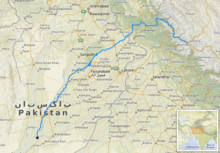
Back نهر تشيناب Arabic نهر تشيناب ARZ চেনাব নদী Assamese Çənab çayı Azerbaijani چناب چایی AZB Чынаб Byelorussian Чанаб Bulgarian चिनाब नदी Bihari চন্দ্রভাগা নদী Bengali/Bangla Chenab Catalan
| Chenab Chandrabhaga | |
|---|---|
 The Chenab river at Ramban, Jammu and Kashmir, India | |
 Location of the Chenab [1] | |
| Location | |
| Country | India, Pakistan |
| Flows through (areas in India) | Himachal Pradesh, Jammu and Kashmir |
| Flows through (areas in Pakistan) | Punjab |
| Physical characteristics | |
| Source | Baralacha La pass |
| • location | Lahul and Spiti district, Himachal Pradesh, India |
| • coordinates | 32°38′09″N 77°28′51″E / 32.63583°N 77.48083°E |
| Mouth | Confluence with Sutlej to form the Panjnad River |
• location | Bahawalpur district, Punjab, Pakistan |
• coordinates | 29°20′57″N 71°1′41″E / 29.34917°N 71.02806°E |
| Length | 1,974 km (1,227 mi) |
| Discharge | |
| • location | Marala Headworks[1] |
| • average | 977.3 m3/s (34,510 cu ft/s) |
| • minimum | 310.53 m3/s (10,966 cu ft/s) |
| • maximum | 31,148.53 m3/s (1,100,000 cu ft/s) |
| Basin features | |
| River system | Indus River |
| Tributaries | |
| • left | Tawi River, Ravi River |
| • right | Marusudar River,[2] Jhelum River, Neeru river and Kalnai River |
The Chenab River[a] is a major river that flows in India and Pakistan, and is one of the 5 major rivers of the Punjab region. It is formed by the union of two headwaters, Chandra and Bhaga, which rise in the upper Himalayas in the Lahaul region of Himachal Pradesh, India. The Chenab flows through the Jammu region of Jammu and Kashmir, India, into the plains of Punjab, Pakistan, before ultimately flowing into the Indus River. The Battle of Chenab was fought between Sikhs and Afghans on the bank of the river.[3]
The waters of the Chenab were allocated to Pakistan under the terms of the Indus Waters Treaty. India is allowed non-consumptive uses such as power generation. The Chenab River is extensively used in Pakistan for irrigation. Its waters are also transferred to the channel of the Ravi River via numerous link canals.[4][5][6]
- ^ ftp://daac.ornl.gov/data/rivdis/STATIONS.HTM[permanent dead link], ORNL, Retrieved 8 Dec 2016
- ^ "Construction of power projects over Chenab". Business Recorder. 26 August 2013. Retrieved 16 March 2017.
- ^ ^ Jump up to:a b VSM, D. S. Saggu (2018-06-07). Battle Tactics And War Manoeuvres of the Sikhs. Notion Press. ISBN 978-1-64249-006-0.
- ^ Cite error: The named reference
Naqviwas invoked but never defined (see the help page). - ^ "River Chenab" (PDF). Archived from the original (PDF) on 27 September 2007.
- ^ "Indus Waters Treaty". The World Bank. Retrieved 8 December 2016.
Cite error: There are <ref group=lower-alpha> tags or {{efn}} templates on this page, but the references will not show without a {{reflist|group=lower-alpha}} template or {{notelist}} template (see the help page).